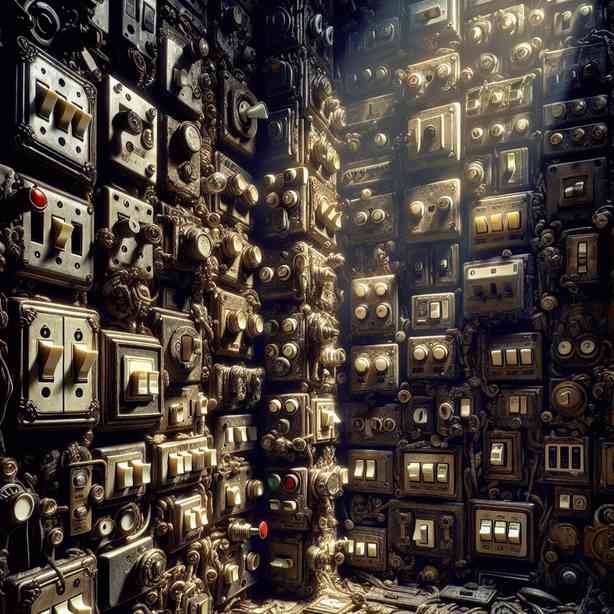
There is a certain kind of light switch that many of us have encountered—an odd little mechanism tucked away in the darker corners of our homes or workplaces. This light switch, which seems to serve no purpose, can evoke feelings ranging from curiosity to frustration. Often, it exists in a state of anonymity, serving as a mystery that lingers in our minds. Today, we will delve into the enigma of that one elusive light switch and explore the various aspects surrounding it, shedding light on its potential uses, the psychology behind our fascination with such objects, and the practical implications of unrecognized functionality.
To begin with, let’s acknowledge that almost every home contains an assortment of light switches. Some are straightforward, linked directly to lights, while others appear to have no immediate application. This brings us to the first key question: why do certain light switches exist without a clear purpose? In a world dominated by functionality, the presence of a seemingly useless switch can be perplexing. However, the mystery may be less about function and more about tradition. Many homes, especially older ones, were constructed with light switches that correspond to fixtures or outlets that have long since been removed or updated. Therefore, a seemingly useless switch could simply be a remnant of an earlier time or architectural style.
Understanding the concept of legacy can help demystify the light switch in question. Often, homes are retrofitted or renovated, abandoning previous electrical layouts in favor of modern amenities. This leaves behind ghostly traces of what once was, including those light switches left in their original locations. If your home was constructed in the mid-20th century, for instance, you might find a switch connected to a lamp or chandelier that was removed in a prior update. In this context, the switch serves as a historical artifact more than a functional component.
Moreover, the psychology behind our reaction to these abandoned switches can tell us a lot about human behavior. The curiosity that arises when we encounter a light switch with no apparent function reflects an intrinsic desire to make sense of our surroundings. This desire extends beyond just light switches; it encompasses our need to organize and interpret the world around us—apply logic where it may not inherently exist. For many, the challenge of discovering the switch’s purpose can be an engaging puzzle, invoking an exploration of our space and encouraging active curiosity. The act of flipping the switch, even without expectation, can embody a sense of adventure—the anticipation of unearthing a long-forgotten function that may change our relationship with the space altogether.
Alongside the psychological implications of these switches is the practicality of addressing them. Homeowners often face the dilemma of whether to keep the switch as is, to rewire it for actual use, or to remove it entirely. The decision can be guided by several factors, including aesthetic preferences, the desire for functionality, and even the historical value of maintaining certain features of the home. If the switch might control something that is still present, like an outdoor light or a seldom-used room, it could be worthwhile to investigate its potential. Additionally, an unused switch can serve as an opportunity for creative expression; many homeowners have transformed these redundant switches into art pieces or additional outlet sources, showcasing their creativity while reclaiming that space.
The presence of these switches can also foster a sense of nostalgia and connection to previous occupants. Imagine a family gathering in a home, each generation having their own experiences tethered to different aspects of the house. Unused or unidentified switches can prompt storytelling sessions where memories flood back—perhaps relating to that one light fixture that hung in the dining room or a hallway rarely traversed but remembered fondly. In this manner, even a seemingly insignificant switch can carry much more than its weight in electrical function; it can connect individuals to their history while fostering deeper relationships among inhabitants.
In an age where minimalism and decluttering reign supreme, you might wonder whether it is worth keeping such switches in our homes. In some cases, embracing the quirky areas of our spaces can actually enhance their charm and personality. Instead of viewing these switches purely as waste or inconvenience, they can be celebrated as the conversation starters they have the potential to be. A light switch that serves no apparent function can bring visitors into deeper conversations about the history of a home or ignite moments of curiosity and imagination.
For those embarking on home renovation or construction projects, discussing the fate of these mysterious switches with your electrician can be a wise choice. Understanding whether they are still operational or if perhaps they can safely be removed or repurposed can save resources and maintain safety throughout your project. Ensuring that you’ve examined what purpose, if any, these switches may serve can ultimately yield a more informed and satisfying renovation outcome.
In conclusion, the myriad of distinct feelings, curiosities, and practicalities surrounding that one light switch you never find allows us to see it in a light entirely of its own. Beyond its functional appearance, it embodies history, evokes nostalgia, and presents opportunities for creativity and even relationships. So, the next time you come across a light switch in your home or elsewhere, take a moment to ponder its existence. It may just be a simple toggle, but within the context of your life and space, it can hold stories, inspire curiosity, and even come to symbolize the very complexity of our human interactions with the spaces we inhabit. Embrace the mystery, because sometimes, it’s the things we don’t immediately understand that can shine the brightest light on our personal and collective journeys.


